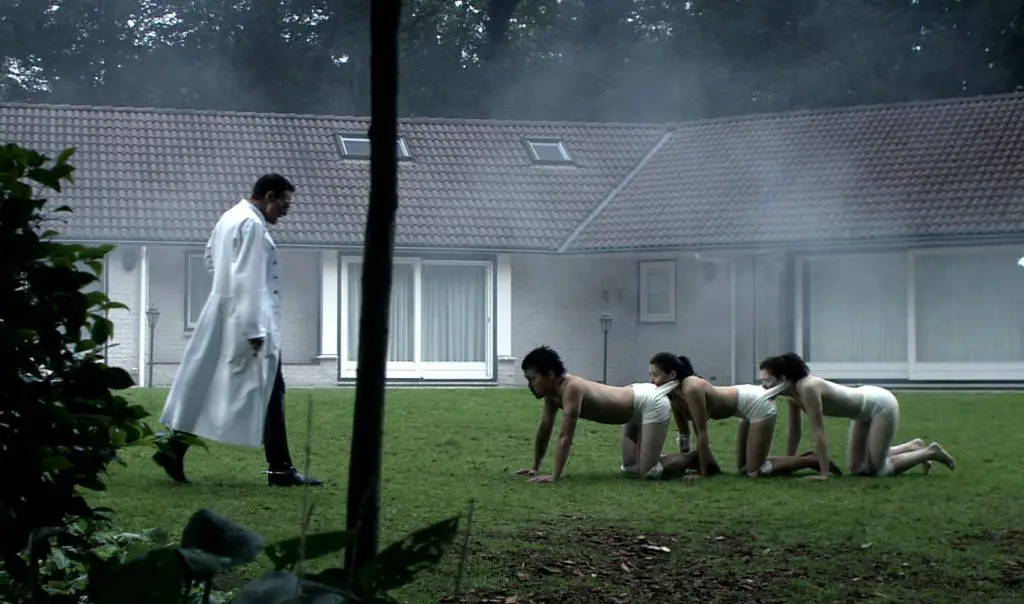 he Human Centipede films have created a newfound fascination with the dark and twisted topic of body modification while also sparking controversy. Dr. Josef Mengele, a Nazi doctor who conducted inhumane medical experiments on prisoners during World War II, is credited by some as the inspiration for this horror phenomenon. In this article, we explore the historical context of Dr. Mengele’s work and its relationship to the Human Centipede films, as well as how it has impacted popular culture and its implications on society today.
he Human Centipede films have created a newfound fascination with the dark and twisted topic of body modification while also sparking controversy. Dr. Josef Mengele, a Nazi doctor who conducted inhumane medical experiments on prisoners during World War II, is credited by some as the inspiration for this horror phenomenon. In this article, we explore the historical context of Dr. Mengele’s work and its relationship to the Human Centipede films, as well as how it has impacted popular culture and its implications on society today.
Historical Context of Dr. Mengele and WWII
Dr. Josef Mengele was an infamous Nazi doctor who conducted cruel medical experiments on prisoners of Auschwitz, a concentration camp in Poland, during World War II. His work focused on human genetics and included such atrocities as forced sterilization, injection of chemicals, and amputation of limbs.
The Nuremberg Laws, issued by the Nazis in 1935, forbade marriage or sexual relations between Jews and other Germans. These laws were designed to support the Nazi ideology that Jews were an inferior race. This set the stage for the eventual Holocaust, which began in 1941 when Hitler ordered the extermination of Jews and other undesirables.
During this time, Dr. Mengele’s experiments flourished under the guise of “scientific research.” He conducted experiments without anesthesia or consent from his victims and often used children as his test subjects. His goal was to create a “master race” with increased intelligence, beauty, strength, and physical features that he deemed desirable.
He also experimented with twins in order to discover how two people with similar genetic makeup could be altered to look different from one another through surgery or chemical injections. The results of these horrific experiments are still felt today by those who were subjected to them as well as their families and descendants.
In 1945, The Allies liberated Auschwitz, but Mengele had already fled at this point. However, his legacy lives on in popular culture today through references to his work in films such as Human Centipede, which is based on some of his more extreme experiments carried out on prisoners at Auschwitz concentration camp during WWII.
Overview of the Human Centipede Films

The Human Centipede films are a series of horror movies written and directed by Tom Six. Released in 2009, the central premise of the film is a mad scientist who surgically connects humans together to form what he calls a “human centipede”.
The first film follows an evil German doctor, inspired by Dr. Mengele’s experiments in Auschwitz, as he kidnaps three people and attempts to connect them together via surgery into one large living organism: a human centipede. The sequels follow similar plots but with more extreme violence and horror elements.
The Human Centipede films have been met with mixed reviews from critics, but have become a cult favorites among horror fans for their unique blend of shock value and dark humor. The movies feature graphic violence, intense scenes of torture and horror, and dark themes of psychological manipulation. At the same time, they also contain elements of black comedy that can be quite humorous despite the grim subject matter.
In addition to its extreme nature, the Human Centipede series also has an interesting cultural impact on society. It has been suggested that these films serve as commentary on topics such as conformity and control in society, or even the loss of individual autonomy when faced with oppressive forces like government or societal norms.
Regardless of how one feels about it personally, there is no denying that the Human Centipede films have made an impact on popular culture; it is hard not to feel something upon watching these extreme movies! Whether this feeling is terror or admiration for Tom Six’s bold writing style, it cannot be denied that these films are here to stay – at least until someone comes up with something even more shocking!
Relationship of the Human Centipede to Dr. Mengele

The Human Centipede films provide an important commentary on the twisted and cruel experiments conducted by Dr. Josef Mengele during his time in Auschwitz. His intention was to create a “master race” that would be superior to all others, and this is represented in the movies through its extreme portrayal of connecting three people together via surgery into one large living organism. This concept echoes some of Dr. Mengele’s most infamous methods and makes us think about why such acts were committed in the past as well as their implications on society today.
The disturbing imagery from the Human Centipede series serves as a reminder that human beings should never be treated like objects or used for unethical experimentation, which is something we must all strive to remember no matter how uncomfortable it may make us feel at times. By making us consider these difficult topics, it allows us to see how far we have come since then but also shows how much more progress still needs to be made in order for everyone around the world to live with dignity, respect and freedom from oppression of any kind.
The Impact of Dr. Mengele on Popular Culture

The legacy of Dr. Josef Mengele has been deeply embedded in popular culture since the end of World War II. His name and the atrocities he committed during his time at Auschwitz have been referenced in films, television shows, books, songs, and social media for decades. Despite the horrific nature of his experiments, some works have used his methods as a source of inspiration for horror films and other works of art.
The Human Centipede series is perhaps the most famous example, with its first installment released in 2009. The film follows an evil doctor inspired by Dr. Mengele’s methods who kidnaps three people and attempts to connect them together via surgery into one large living organism: a human centipede. While it has received mixed reviews from critics due to its extreme violence and graphic scenes of torture, this cult-favorite horror movie has become a lasting influence on popular culture.
Dr. Mengele’s influence can also be felt beyond cinema too; his legacy still resonates in contemporary culture today. Many people are aware of his gruesome experiments, sparking conversations about ethics in science and the dangers of medical experimentation without proper regulation or oversight. Not only that but many artists across disciplines have used him as a source of inspiration for their work: from novels like The Boy Who Followed Mengele (2018) to songs such as Iron Maiden’s “Doctor Doctor” (1985).
What is more, Dr. Mengele’s legacy is constantly being discussed online on social networks like Twitter and Reddit – albeit sometimes with misplaced references to Nazi Germany or Holocaust-related subjects – where it serves both as a reminder that progress still needs to be made for everyone to live with dignity, respect, and freedom as well as a way for people to reflect upon past atrocities so they are not repeated in future generations.
It is clear that Dr. Mengele’s legacy lives on even after all these years through its influence on popular culture today – influencing our movies, music, and conversations alike – reminding us all that we should never forget what happened during WWII or take our freedoms lightly today.
Implications of the Human Centipede On Society
The Human Centipede films have sparked a discussion about the implications of Dr. Mengele’s legacy on modern society. It is an extreme example of body horror, combining medical experimentation with violence and torture, as well as commentary on power dynamics and dominance over others. The film serves as a reminder of the atrocities committed in Nazi concentration camps during World War II and their implications for contemporary society.
The movie has also been used to comment on sexual violence and consent, raising questions about what constitutes ethical behavior in relationships between people. Through its depiction of extreme body modification, it also invites us to consider how far is too far when it comes to using medical techniques for punishment or revenge.
The Human Centipede movies have caused many people to reflect on what it means to be human and the moral boundaries that define us; not just in terms of our physicality but also our psychological state. It invites viewers to consider how we treat each other, especially those who are vulnerable or may not understand the consequences of their actions. It causes us to think about how much control we should be willing to cede over another person’s body, both legally and ethically speaking.
In conclusion, the Human Centipede films serve as a powerful reminder of Dr. Josef Mengele’s legacy at Auschwitz and how his experiments still affect popular culture today. Through its exploration of body horror, power dynamics, and ethical dilemmas, the movie encourages us all to reflect upon our own beliefs and assumptions regarding morality, consent, and respect for one another’s humanity.
Avid Writer with invaluable knowledge of Humanity!
Upcoming historian with over 30 million views online.
“You make your own life.”





